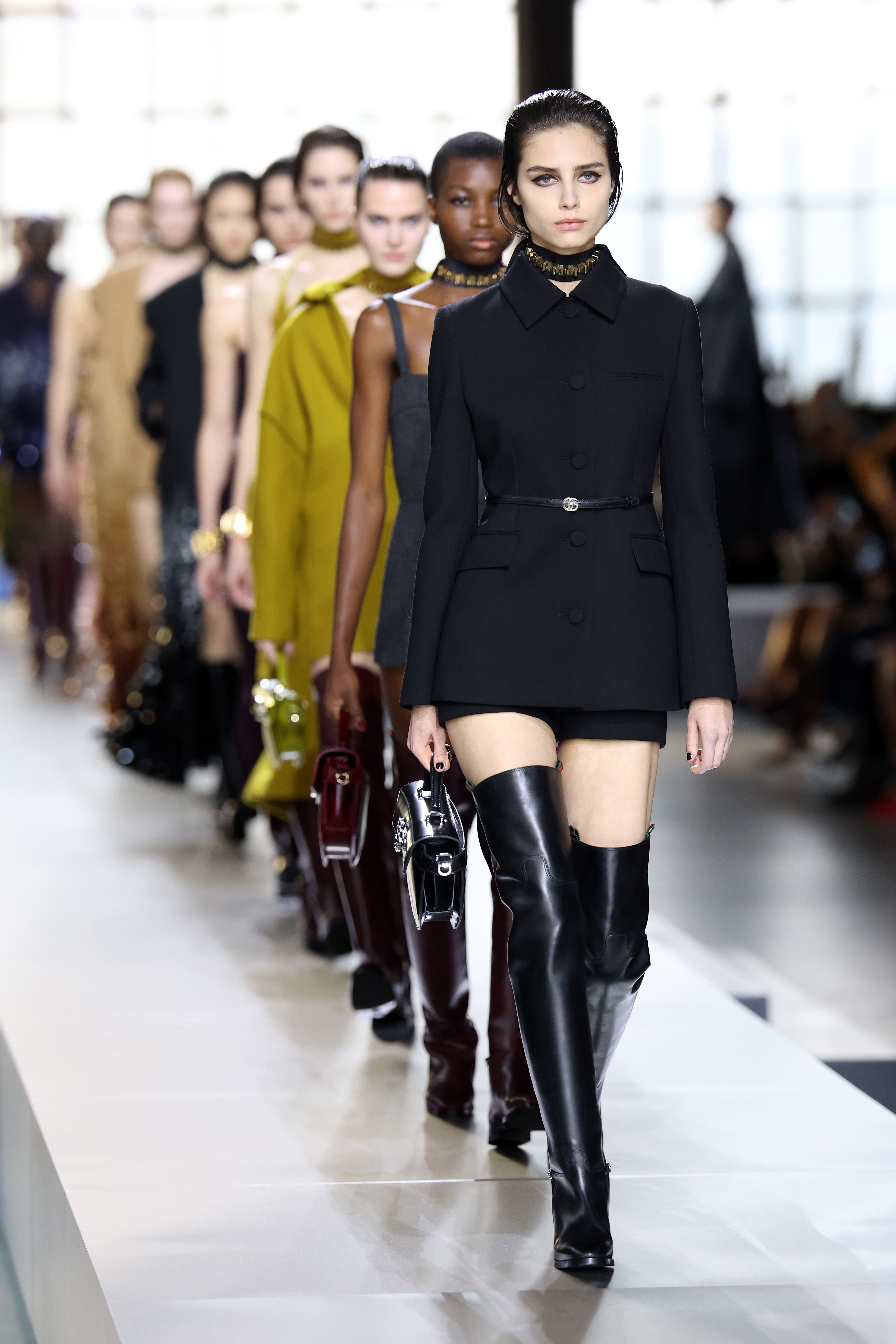Gucci and Tom Ford: The Ease of Repetition, the Challenge of Change
MILAN â The manifesto that Sabato de Sarno supplied with his new collection for Gucci set him a trap in the sense that it created expectations that his own inclinations made it unlikely for him to meet. Coats are clearly his passion. Itâs probably not a giant leap to imagine that the perfect coat might be his holy grail as much as the perfect sleeve was Cristobal Balenciagaâs. De Sarno suggested as much when he referred to the making of a coat as âa meticulous journey,â with the new collection being âan obsessive repetition of that journey.â
The word ârepetitionâ immediately leapt out. De Sarno has already proved himself partial to the idea with the âmirroringâ presentations â same staging, same soundtrack, almost the same opening look â he offered for his first womenâs and menâs shows for Gucci. The model who opened his latest show was Ana Rossolovich, the new face who launched his debut. He still feels she embodies his vision for the brand. De Sarno is clearly not a designer who is going to zap us with the shock of the new. Thereâs absolutely nothing wrong with that. Thereâs only one Miuccia Prada, one Rick Owens in this world. But De Sarno closed the trap on himself when he pledged to âcapture the extraordinary where the ordinary is expected.â I donât expect the âordinaryâ â why sell yourself short? â but, in the same vein, I also recognise how rare and precious âthe capture of the extraordinaryâ is. Most of what I see unfolds in some intermediary zone between the two. Again, nothing wrong with that. So maybe I should just sit back and enjoy De Sarnoâs quest.
The story that his collection told was easily distilled into a few key elements. Closest to the designerâs heart was surely the very-long-over-very-short proportion involving those coats â impressively, almost militarily, scaled â that he loves. Other outerwear staples â parkas, pea coats â were cropped into boxy coat dresses. A counterpoint was offered by sheer lace lingerie/slip dresses. And almost all of it was anchored by either riding boots, evoking Gucciâs equestrian roots, or thigh boots. The show closed, for instance, with a black buster sheath slashed to just below the groin, fluttering over black-leathered legs. The model wore a chunky metallic choker which spelled out GUCCI.
That particular look cued the curiously fetishistic impression given off by the whole presentation. Maybe thatâs where âobsessive repetitionâ leads. In Tom Fordâs day, such an impression would have been quite deliberate. Hell, it was practically a selling point. Who even knows yet what De Sarnoâs selling points are? One thing he has in his favour is that he definitely holds fast to a point of view. How persuasive can such conviction be? Well, the über-influential musician Brian Eno once proposed that repetition is a form of change. And change is, after all, the fuel of fashion. So maybe De Sarnoâs grand design for Gucci is simply a slow reveal.
Perhaps itâs too obvious to segue from Gucci to Tom Ford given the shared history of the brands. Or maybe that just doesnât matter given that the comparison offers a peerlessly irresistible opportunity to focus on the challenges inherent in succeeding a charismatic, definitive personality. Resist or embrace? Iconoclast or understudy? Peter Hawkings clearly loves being in control at Tom Ford after 25 years working as Fordâs right hand. âIâm creating my woman, my man,â he said emphatically before his show on Thursday.
Hawkings insisted there was no archive-diving. Itâs all forward with Ford. If the shadow cast by his old boss was as long as the spotlight-dappled catwalk in the outré revelation of clinging mesh or near-nude net confections, Hawkingsâs experience as Fordâs menswear designer suggested he was probably more at ease with the gold-buttoned navy looks or the pin-sharp tailoring of three-piece suits, worn shirtless by all genders. When he showed see-through flasherâs macs in latex, they were primly buttoned to the throat. (His first fragrance for the brand is tellingly named Vanilla Sex.)
But Hawkings insisted the inspirational creature he had in mind for his collection â his powerhouse wife Whitney aside â was actually the Pola Woman, the strong-shouldered dominatrix archetype who ruled photographer Helmut Newtonâs fetishistic universe. âPowerful, glamorous, free to be as dressed or undressed as she chooses,â was how he described her. Hawkings imagined his tailoring as a kind of armour, elevating her, keeping her standing tall.
As ever with this brand, the women were women, and the men came across as boys by comparison. In that, Peter echoed his mentor Tom. There were, after all, no Pola Men in Newtonâs world. At the same time, Hawkingsâs amped-up power dressing â itâs emerging as a major trend for next season â underscored the clear irony that thereâs scarcely been a time when people had less power to impact on the events that are shaping their lives, generally for the worse. This was power as cosplay, as a fantasy of escape even. The sensation was dislocating.

